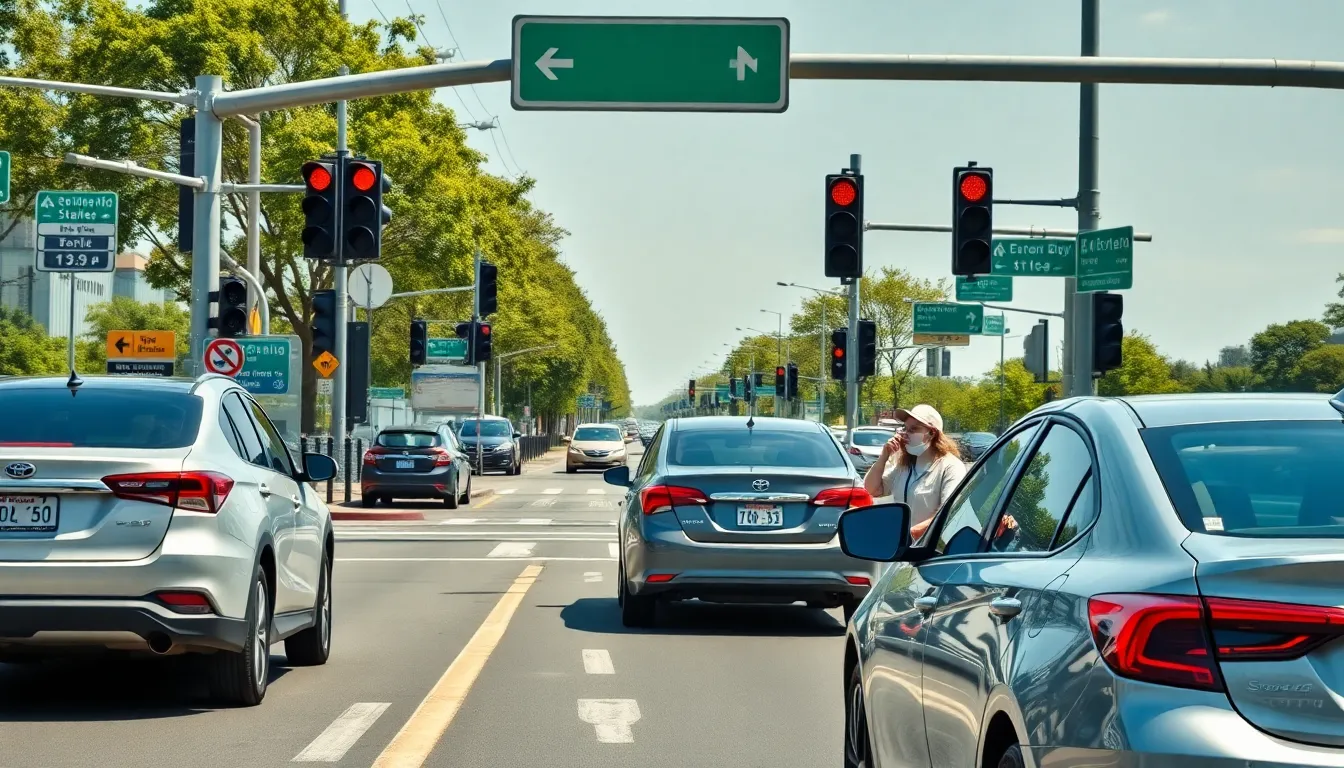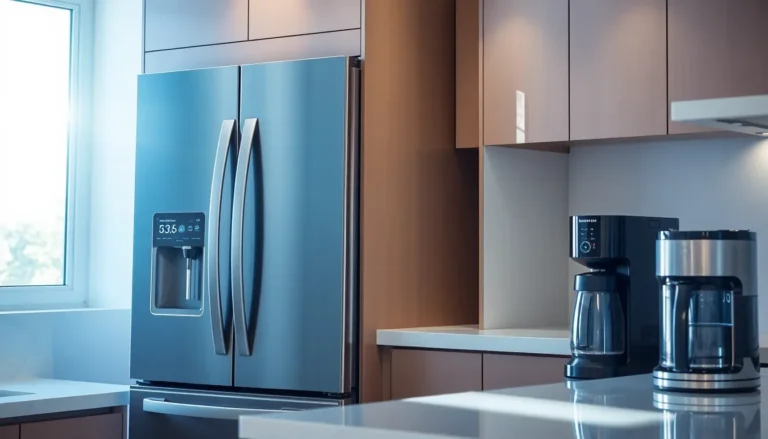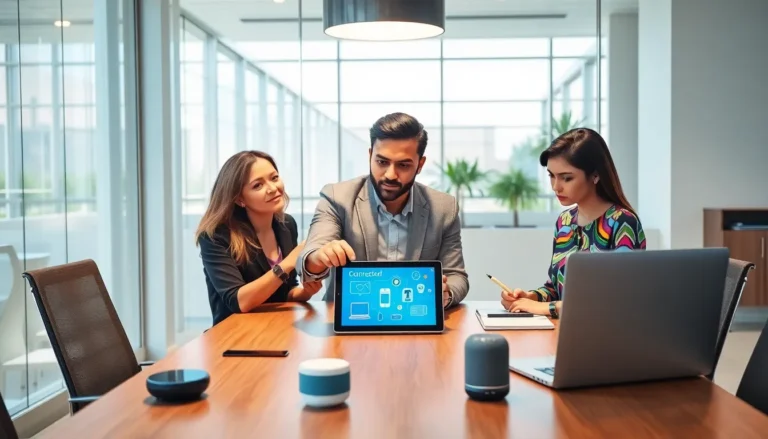Imagine a world where cars chat with each other like old friends at a coffee shop. That’s the magic of V2X communication, where vehicles connect with everything around them—from traffic lights to pedestrians. It’s not just about avoiding fender benders; it’s about creating a seamless driving experience that makes roads safer and smarter.
Table of Contents
ToggleOverview of V2X Communication
V2X communication refers to the technology enabling vehicles to communicate with various entities, including other vehicles, infrastructure, and pedestrians. This system enhances traffic efficiency, fosters safer road navigation, and supports smart city initiatives.
What is V2X Communication?
V2X communication encompasses several modes: Vehicle-to-Vehicle (V2V), Vehicle-to-Infrastructure (V2I), Vehicle-to-Pedestrian (V2P), and Vehicle-to-Network (V2N). V2V allows vehicles to share information on speed, direction, and road conditions. V2I connects vehicles to traffic signals and road signs, optimizing traffic flow. V2P focuses on interactions between vehicles and pedestrians to enhance safety. V2N allows vehicles to access cloud-based services and updates, improving the driving experience.
Importance of V2X Communication
V2X communication plays a crucial role in reducing accidents and improving traffic management. It facilitates real-time data sharing between vehicles and their environment, which can significantly decrease collision rates by alerting drivers to hazards. Furthermore, V2X communication contributes to efficient traffic signal management, minimizing congestion and enhancing fuel efficiency. The integration of this technology supports the development of smart cities, where vehicles and infrastructure work seamlessly together.
Types of V2X Communication
V2X communication encompasses various types that facilitate interactions between vehicles and their surroundings. Each mode plays a crucial role in enhancing road safety and traffic efficiency.
Vehicle-to-Vehicle (V2V)
V2V communication allows vehicles to exchange critical data, such as speed, direction, and road conditions. This real-time information sharing can prevent collisions by alerting drivers to potential hazards within their vicinity. For instance, if one vehicle detects sudden braking ahead, it can communicate this to surrounding vehicles, enabling timely responses. Collision avoidance systems become more effective with V2V technology, significantly reducing accident rates. Moreover, V2V supports traffic flow optimization by helping vehicles adjust their speeds according to real-time traffic conditions.
Vehicle-to-Infrastructure (V2I)
V2I communication connects vehicles directly to traffic management systems and infrastructure elements, such as traffic signals and road signs. Vehicles receive vital information about traffic light changes, road closures, or construction zones, allowing for smoother and safer navigation. For example, a vehicle receiving real-time updates about an upcoming red light can adjust its speed accordingly, reducing sudden stops. This connection enhances traffic management and minimizes congestion by facilitating better-informed routing decisions. Additionally, V2I contributes to energy efficiency by optimizing traffic flow, maintaining consistent speeds, and reducing unnecessary idling.
Vehicle-to-Pedestrian (V2P)
V2P communication enhances safety for pedestrians by allowing vehicles and mobile devices to exchange information. Pedestrians equipped with connected devices can inform nearby vehicles of their presence, enabling cars to respond to their movements appropriately. This interaction significantly decreases the risk of accidents in urban settings. For instance, vehicles can receive alerts when pedestrians are crossing, even if they are obscured from view. V2P systems provide alerts to both drivers and pedestrians, promoting safer coexistence in shared spaces. Overall, this communication type fosters a safer environment for individuals on foot.
Vehicle-to-Network (V2N)
V2N communication connects vehicles to external networks, including cloud services, enabling them to access a wealth of information and resources. This connectivity allows vehicles to receive updates on traffic conditions, weather forecasts, and emergency alerts in real-time. Additionally, V2N facilitates access to navigation services, enhancing route planning with the latest data. For instance, vehicles can reroute based on real-time congestion reports or road closures. The integration of V2N enhances the driving experience and supports smart city initiatives, as vehicles dynamically adapt to changing environments and conditions.
Technologies Enabling V2X Communication
V2X communication relies on various technologies to facilitate efficient interaction among vehicles, infrastructure, and pedestrians. Both short-range and long-range communication technologies play vital roles in this ecosystem.
Short-Range Communication Technologies
Dedicated Short-Range Communication (DSRC) operates within a range of approximately 300 meters, enabling vehicles to exchange data rapidly. This technology supports low-latency communication critical for safety applications. Another important technology, Cellular Vehicle-to-Everything (C-V2X), utilizes 4G and 5G networks for direct communication among vehicles and between vehicles and infrastructure. C-V2X enhances situational awareness by enabling vehicles to send and receive messages with minimal delay. Ultra-Wideband (UWB) technology provides precise location data, improving safety for pedestrians by ensuring vehicles detect their presence in real-time. Short-range technologies enhance immediate communication, ensuring efficient responses to changing road conditions.
Long-Range Communication Technologies
Long-range communication technologies extend the capabilities of V2X systems beyond immediate surroundings. Satellite communication plays a significant role in providing vehicular data over vast distances, particularly in remote areas with limited cellular service. This technology helps vehicles access real-time traffic updates and navigation information. Furthermore, the integration of cellular networks facilitates long-range connectivity for vehicles, allowing access to cloud-based services and real-time data from vast networks. Emerging technologies, including Low Earth Orbit (LEO) satellites, promise improved bandwidth and lower latency, enhancing communication reliability. Long-range technologies ensure that vehicles stay connected regardless of their location, promoting safety and optimized navigation.
Benefits of V2X Communication
V2X communication offers significant advantages, transforming road safety, traffic management, and environmental conservation. This technology fosters a harmonious connection between vehicles and their surroundings, driving improvements across various domains.
Safety Improvements
Safety improvements rank among the most critical benefits of V2X communication. Vehicles equipped with V2V technology exchange real-time data, informing each other about speed, direction, and road conditions. This information exchange drastically reduces collision risks. In urban settings, V2P communication alerts vehicles to the presence of pedestrians, significantly enhancing their safety. With such systems in place, situations that previously led to accidents can be effectively mitigated.
Traffic Efficiency
Traffic efficiency also sees a remarkable boost through V2X communication. V2I connections enable vehicles to receive live updates from traffic management systems, optimizing routes based on current road conditions. By communicating with traffic signals, vehicles can adjust their speeds to match signal changes, minimizing stops and delays. In effect, these advancements lead to smoother traffic flows, decreasing congestion and travel times. Continuous data sharing allows for the identification of patterns that inform better infrastructure planning, further enhancing overall efficiency.
Environmental Impact
Environmental impacts present another important consideration in V2X communication. By improving traffic flow, V2X systems reduce fuel consumption and emissions. Streamlined journeys mean vehicles spend less time idling, which lowers greenhouse gas emissions. The integration of smart traffic management and optimized routing also contributes to a decrease in energy usage. Such strategies support broader sustainability goals, promoting cleaner urban environments while addressing the challenges posed by increasing vehicle numbers.
Challenges and Limitations
V2X communication faces several challenges and limitations that must be addressed for widespread implementation and success.
Technical Challenges
Technical challenges present significant hurdles for V2X communication. Ensuring interoperability across various vehicle models and infrastructure types requires robust technical frameworks. Network latency impacts real-time data exchange, potentially compromising safety features. Wireless communication protocols, such as DSRC and C-V2X, need extensive testing to ascertain reliability under diverse conditions. Security also presents critical concerns, as vulnerabilities in data transmission could expose vehicles to cyber threats. Moreover, maintaining consistent connectivity in urban environments with high vehicle density poses additional challenges.
Regulatory and Standardization Issues
Regulatory and standardization issues are crucial for V2X deployment. Currently, a lack of uniform regulations across jurisdictions hinders the development of a cohesive V2X ecosystem. Governments need to establish policies that support technology integration and protect user privacy. Furthermore, standardization of communication protocols is vital for devices from different manufacturers to interact seamlessly. Industry stakeholders must collaborate to create widely accepted technical standards. Ongoing dialogue among manufacturers, regulators, and researchers aims to address these concerns and foster a safe, efficient V2X environment.
Conclusion
V2X communication stands at the forefront of transforming transportation as it connects vehicles with their environment. This technology not only enhances safety but also streamlines traffic flow and supports sustainable urban development. As advancements continue in communication technologies, the potential for V2X to create smarter cities becomes increasingly tangible.
Overcoming challenges such as interoperability and security will be essential for its successful implementation. Collaboration among stakeholders is vital to establish the necessary standards and policies. With ongoing innovation and commitment, V2X communication can redefine the driving experience and significantly improve road safety for everyone.







